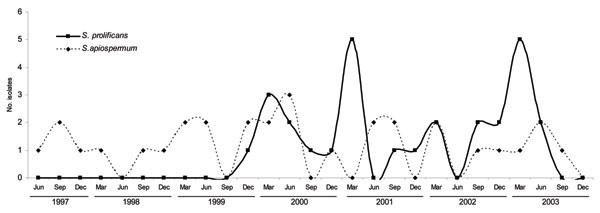Volume 13, Number 8—August 2007
Research
Infection with Scedosporium apiospermum and S. prolificans, Australia
Figure

Figure. Epidemiologic curve of isolation of Scedosporium spp. isolation, Australia, June 1997–December 2003. S. prolificans was first identified in December 1999 and had 2 peaks that coincided with construction work. S. apiospermum was isolated at a constant rate of 1–2 times per 3-month period.
Page created: June 30, 2010
Page updated: June 30, 2010
Page reviewed: June 30, 2010
The conclusions, findings, and opinions expressed by authors contributing to this journal do not necessarily reflect the official position of the U.S. Department of Health and Human Services, the Public Health Service, the Centers for Disease Control and Prevention, or the authors' affiliated institutions. Use of trade names is for identification only and does not imply endorsement by any of the groups named above.